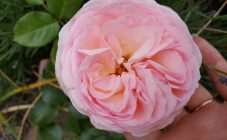Content:
Novice growers prefer to choose roses that are easy to care for. Breeders have bred enough varieties that are admired for their decorativeness and ease of care. One of these varieties is Queen of Hearts, a rose belonging to the floribunda group.
Rose Hearts
Floribundas appeared in 1924 as a result of crossing tea and polyanthus, as well as muscat roses. This group of varieties is highly resistant to diseases, rain, frost. Floribundas have incorporated the best characteristics of their predecessors.
Rose Queen of Hearts was bred as a separate variety in 2008, in Germany, in the Kordes nursery.
Description of the variety
Rose Hearts has a unique salmon orange color. The flowers are double, up to 120 petals in one bud, which reaches 10 cm in diameter. The plant reaches 0.8 m in height and up to 0.4 m in width. The flowering is abundant and long, until mid-autumn. The flowers are resistant to rain and have a light scent. Flowers may fade slightly under the sun. Stems are straight, tough. The leaves are dark, with a slight glossy shine, they perfectly set off and complement the peach color of the roses.
Rose Queen of Hearts is highly resistant to diseases, especially to black spot and powdery mildew, and is also resistant to frost, but in central Russia, bushes need shelter for the winter.
Features of agricultural technology
Rose Hearts is easy to plant and maintain. Prefers sunny, windless areas. It burns out slightly under direct sun, so cut bushes are recommended to be planted under diffused sunlight. It is not recommended to plant this variety in the shade or in the lowlands.
A distance of at least 40 cm should be maintained between the seedlings so that the roots have enough space, nutrients and moisture.
The plant needs abundant and regular watering, which should only be done in the evening. Water should be poured strictly at the root, make sure that moisture does not get on the leaves and buds. Only in very hot weather can the rose be lightly sprayed with water.
You need to feed the plant throughout the season, once every 3 weeks. Do not forget to alternate organic fertilizers and mineral fertilizers.
Bush pruning is carried out 2 times a year: in spring, to form a bush, and in autumn, to prepare for wintering.
This variety is winter-hardy, but it is recommended to cover it for the winter. In the fall, you need to remove the leaves and dry flowers, burn them. Trim and huddle the bush, creating a mound of 30 cm.Cover with spruce branches and a special material, for example, lutrasil.
In the spring, when the weather is warm, the shelter is removed. The cover removed in time will prevent the plant from rotting.
The plant propagates by cuttings. A young bush should sit in one place for about 2 years, after which it must be transplanted to a permanent place. The first flowers need to be cut off: they interfere with the development of the root system.
Advantages and disadvantages of the variety
Pros of Rose Hearts:
- universal in use, except for border landings;
- winter hardy, resistant to rain;
- high resistance to diseases;
- abundant and long flowering;
- easy care.
Minuses:
- an abundance of thorns;
- slight fading of the flower under direct sun.
This variety is loved by many gardeners for its high resistance to harsh weather conditions and diseases, as well as for its easy maintenance and beautiful color.














